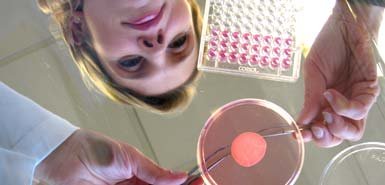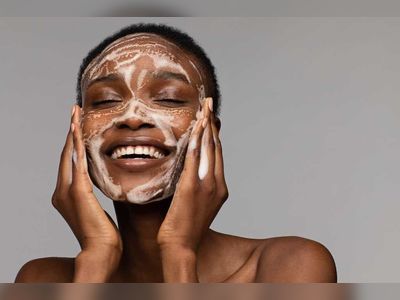Tucked away in Lyons is a small laboratory where technicians, made anonymous by their blue gowns, masks, hats, gloves and footwear, work quietly. When they remove their garb, you find, unusually for scientific staff, that they are almost entirely female.
This is the team that has grown human skin from the leftovers of cosmetic operations. The resulting living epidermis, called Episkin, is used in tiny samples to test cosmetics, avoiding the need to use animals. This is significant because, from next year, the EU Cosmetics Directive will ban the use of animals in testing cosmetics and their ingredients.
L’Oréal, the cosmetics company that runs the lab, secured a breakthrough last May when Episkin, which has taken more than 20 years and £500 million to develop, was awarded validation by a European Commission regulator as an official alternative to animal testing for skin irritancy. The regulator ruled it as at least as good as a rabbit test.
As a result, the Episkin lab is expanding. Last year it produced 108,000 skin samples, which are either used to test L’Oréal products – including Lancôme, Maybelline and Garnier – or sold to competitors to test their goods for skin irritancy.
Building work is about to start on a new unit next door for 20 new staff, which will increase capacity to 360,000 samples in 18 months.
How artificial skin is made
After a few days these cells, called keratino-cytes, attach together to form
an epidermal sheet of skin, similar to those used for grafts.
The samples, each the size of a 2p piece, are placed in a culture medium with
water, amino acids and sugar, supported on a collagen matrix. The cells form
a living tissue that has a shelf life of about a week, but when frozen in
liquid nitrogen, it can be stored for years. To test for irritancy,
cosmetics are applied on top of the tissue; after 18 hours they are rinsed
off and a yellow chemical called MTT is added. If the tissue turns blue,
which means that it is still alive, the cosmetic is judged a nonirritant.
Saving animals
This pioneering work is attracting a lot of attention. Barney Reed, a senior
scientist at the RSPCA, describes it as a “very welcome step in the right
direction”. He adds: “It is an illustration of what can be achieved with the
right moti-vation and resources.”
Although the number of animals used for testing on cosmetics has dropped
dramatically in recent years – with the UK voluntarily abandoning animal
testing in 1997 – figures from the RSPCA show that, in 2005, 5,571 animals
were used to test substances used mainly as cosmetics or toiletries across
the EU (excluding the UK) – 1,797 mice, 2,226 rats, 940 guinea pigs and 608
rabbits. Cosmetics bought in the UK may have been tested on animals, if they
are made abroad.
The development of artificial human skin will not mean the end of animal tests
because they are still required by law in industries such as food,
pesticides and pharmaceuticals. But the European Commission has estimated
that Episkin could spare about 20,000 animals a year.
Human beings benefit, as well as animals
Someone who comes out in a rash after using a new skin cream may worry that
cosmetics tested in this way may not be as safe as those tested on animals.
But scientists believe that, to the contrary, these new tests could be even
more reliable.
Dr Margaret Clotworthy, a science consultant at the Europeans for Medical
Progress Trust, an antivivisection group, said: “Human skin models have been
stringently validated, unlike the animal models they replace. More
human-relevant models are not only good for laboratory animals; they mean
safer products for human beings, too.”
Now that Episkin is established, the company is working on new developments
that will further reduce the need to test on animals, as well as help the
medical world.
Episkin is a model of the human epidermis, the top “horny” layer of skin; the
dermis, the deeper layer, has not been reconstructed. Now L’Oréal is
developing RealSkin, full-thickness skin with both layers. This is achieved
by adding fibroblasts, the main dermal cells, along with collagen and
elastine, to a collagen matrix of the sort used to create Episkin.
This has raised a host of extra possibilities, including increased
understanding of the interaction of the epidermis and the dermis, and the
efficacy of cosmetics on the skin. It has enabled scientists to see the
effect of harmful UVA rays on the dermis, and to study skin ageing, which
has not been possible until now.
Potentially of more interest to women around the world, it raises the
possibility of the development of super antiageing creams to protect and
stimulate the dermis.
Bright eyes – no longer burning like fire
The squirting of shampoos and other lotions into animals’ eyes to assess
irritancy is one of the images that led to the public’s disgust with animal
testing. But L’Oréal is working on the cultivation of ocular epithelium, the
layer of cells covering the cornea. At present, this substance is being
produced at a subsidiary company, SkinEthic, in Nice, but L’Oréal plans to
to move the operation to the Lyons laboratory.
L’Oréal hopes that cultured human corneal tissue will soon gain the same
validation as a nonanimal alternative for testing as Episkin has for skin
irritancy. It will be marketed as Human Corneal Epithelium, or HCE for
short, to test the ocular irritancy of shampoos and other cosmetics.
Dr Estelle Tinois-Tessonneaud, the inventor of Episkin and boss of the Lyons
laboratory (see panel, facing page), has been helping a French military
hospital to use her technology to grow a patient’s skin to use for a graft.
She has helped the hospital to create a sterile room similar to the two in
her laboratory in which to carry out the procedure. It takes about three
weeks to grow sufficient tissue to cover a sizeable burn. The process is not
likely to be used universally in hospitals because it is expensive, but in
certain circumstances, it can be extremely useful.
Animal rescue
Dr Estelle Tinois-Tessonneaud, 45, is the Frenchwoman whose life has been
dedicated to developing the “bionic” skin that she invented.
After a PhD studying human skin at the University of Lyons and further
research, she was given the chance to establish L’Oréal’s Episkin laboratory.
She is the mother of an eight-year-old boy, and her husband is also a
scientist. She admits that it has been difficult for her family: “I work
12-hour days. It’s hard for me, and for my husband. He’s the one who helps
with the homework, and does the shopping and cooking.”
But she is proud of her achievements. “When I tell people I have made
something that will save lots of animals they say, ‘Wow, that’s fantastic.’ ”











